






There are four first hand descriptions of the voyage of the Zeemanshoop from Scheveningen to England that evening. Two are letters written in 1946 by Lou Meijers, a member of the "crew" of four students, and Wim Belinfante, a Dutch Jewish refugee, to H. Th. de Booy, the Secretary of the Dutch Lifeboat Association, the NZHRM. Both letters have been translated into English by Radboud Hack. Follow these links to read Lou Meijers letter in Dutch or English and Belinfante's letter in Dutch or English. The well known account of the voyage in his book about the wartime exploits of the Dutch Lifeboats, Tusschen Mijnen en GrondzeeŽn (G.A. van Oorschot, 1947) is mostly based on these letters. Lou Meijers and Wim Belinfante were interviewed on Dutch Radio in 1989 and can be heard describing the voyage on a Podcast.
A more detailed description of the voyage was written in 1981 by Harry Hack, the "Captain" of the four man crew in order to be accepted as a member of the Society of Engelandvaarders and has been translated into English by his son, Radboud Hack. This remained in the family and has not been published until now. It can be viewed here in Dutch and in English. Finally, Loet Velmans, a seventeen year old school boy in 1940, described the voyage in a chapter of his book, Long Way back to the River Kwai (Arcade, 2003, 2011) which has been published in Dutch as Terug naar de River Kwai, Herinneringen aan de Tweede Wereldoorlog (Walburg Pers, 2005).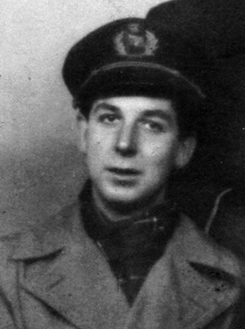
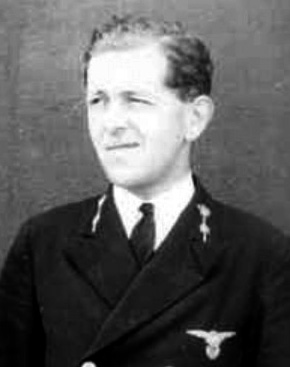 At 1.30 pm the Germans bombed
the heart of Rotterdam and within five hours German troops occupied the
city. Two students at Delft University, Karel Dahmen (on left) and Jo Bongaerts (on right in RAF uniform, courtesy of NIMH),
watched the huge column of smoke as Rotterdam was bombed from the window of their
student digs and were eating their supper when they heard the 6 pm
radio broadcast of the surrender of Dutch
forces. They immediately decided to cycle to Scheveningen and try and find a boat to England. Others were making similar plans.
At 1.30 pm the Germans bombed
the heart of Rotterdam and within five hours German troops occupied the
city. Two students at Delft University, Karel Dahmen (on left) and Jo Bongaerts (on right in RAF uniform, courtesy of NIMH),
watched the huge column of smoke as Rotterdam was bombed from the window of their
student digs and were eating their supper when they heard the 6 pm
radio broadcast of the surrender of Dutch
forces. They immediately decided to cycle to Scheveningen and try and find a boat to England. Others were making similar plans.
Harry
Hack, a 26 year old student of mechanical engineering at Delft
University, was having his supper when his landlady burst in with the
news of the surrender. It was 7 pm and impulsively, without further
thought, he decided to go to England. He set out for Scheveningen on a
borrowed bicycle, shouting out “I’m going to England” as he passed the
Air Protection Post where he was supposed to be on duty and abandoned
the bike when a fellow student gave him a lift in his car. He met Karel
Dahmen and Jo Bongaerts at the fishing harbour where huge sums of money
were being offered by Jewish refugees to any fisherman prepared to
ferry them to England - but without any takers.
Harry Hack suggested taking one of the two lifeboats they could see on the opposite side of the outer harbour, the north west side. "They think there is no chance of this so I go on my own. I jump onboard the smallest lifeboat, the Prins Bernhard. The engine room is padlocked. Let's see if I can get a metal saw from the nearby fishing boat." Karel and Jo changed their minds about the lifeboats and take a look at the Zeemanshoop. It was also padlocked but a steel helmeted sergeant in the Marechaussee,
a military police service, wants to come with them. They use the
bayonet on his rifle to break
the lock on the hatch to the engine compartment. The sergeant has not
been identified (but Otto Neurath described him in a letter to the
architect Josef Frank, 22 September 1942, as "a Jew who wanted to fight
Hitler from England") was accompanied by a woman, his sister or his
wife. They were joined
by Lou Meijers, a first year medical student who had cycled 200 kms
from Groningen.
Karel Dahmen and Jo Bongaerts had been joined by two high school students. Loet
Velmans and his cousin
Dik Speijer, had cycled from their parents homes in the Belgian
quarter of Scheveningen to get a boat to Zeeland where fighting was
still taking place but now decide England was a better option. Loet
told a young boy that if he delivered a note to his parents he could
keep his bike. One of the students saw this transaction, said they had found a lifeboat and asked, "Want to come along?" The
two school boys were flattered to be asked and immediately agreed.
A large crowd had gathered, eager to get to England. Most were Jewish and many were from Germany, refugees for the second time. They included whole families, men, women and young children, some with suitcases, and all smartly dressed. They "all wore or carried over their arms a beige or navy blue raincoat - in 1940 casual clothes were not yet in fashion" (Loet Velmans). A gangway was let down and the boat quickly filled with eager people crammed tightly together on deck.
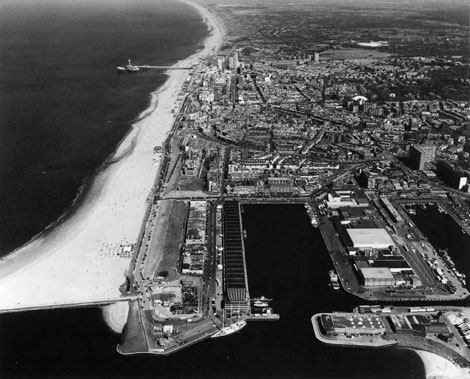
The
Zeemanshoop in the Vissershaven (fishing harbour) at Scheveningen and an aerial photograph showing the layout of the inner and outer harbours
The engineer probably jumped ashore on the Adrian Maasplein
Non of the students knew anything about marine diesel engines.
Jo and Karel went off to seek help leaving Meijers in the engine
compartment. When the fisherman refused to help Harry break into the Prince Bernhard he tries the Zeemanshoop and finds it open. Harry had been an apprentice engineer on a voyage to the Dutch
East Indies and immediately took charge, upsetting Meijers by asking him
not to touch anything and to sort things out on deck. The engine was a 2-cylinder Kromhout MD (44 hp) made in Amsterdam, a hot bulb engine started
by
heating with a hand held blowlamp. Harry knew the basic principles but
had no practical knowledge of how it worked. Fortunately, he had some help:
"While I am trying to figure out how to do his, some help arrives,
apparently a "fisherman engineer". "I'm willing to help you but I will
not go with you". He puts on the pre-heater (with a blowlamp) and after
a while the engine starts" (Harry Hack).
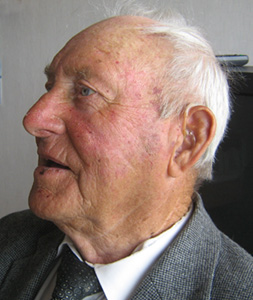 A
hand written note on Meijers letter to the ZNMRH reads "The
engine was started by two Scheveningen men J. Pronk and Martinus
(Tinus) Rog." In
1940 Tinus Rog was a nineteen year old fisherman living with his
parents and when they heard the news of the surrender they told him to
check that that the family's fishing boat was safe and to make sure
that it wasn't stolen. He borrowed his girl friend's bike and cycled to the harbour:
A
hand written note on Meijers letter to the ZNMRH reads "The
engine was started by two Scheveningen men J. Pronk and Martinus
(Tinus) Rog." In
1940 Tinus Rog was a nineteen year old fisherman living with his
parents and when they heard the news of the surrender they told him to
check that that the family's fishing boat was safe and to make sure
that it wasn't stolen. He borrowed his girl friend's bike and cycled to the harbour:
It
was swarming with people. There were lots of Jews and
soldiers walking round. A suitcase fell open and he saw it was
full of gold and silver but thought that was none of his business. After a while somebody approached and
asked him: "Are you from Scheveningen? Can you start an engine" He said
he could and went on board the Zeemanshoop. Tinus asked him, "Do you have a permission to take
the lifeboat" and they said they did. He
started the engine and told one of the men to make sure to top up the
lubricating oil when it got low and told them how to do it. He also asked, "Do you know how to
set the course?" They didn’t so he explained how to use the compass and
told them to stick to NW. They wanted to know if he would like to come with
them but he said no and was dropped off at the end of the breakwater
(known as the ‘pipe’) on the right hand side and had to climb over a high fence
to get back. He was very upset to find the bicycle which belonged to
his girl friend had been stolen
but somebody saw who took it and gave him the address. He went there
and
the man warned him, "Don’t tell anyone what you did because if the
Germans
find out, you will be in big trouble". He didn’t even tell his parents
or his girl friend until after the war. Not long
after the war ended someone came by and thanked him. It was one of
the passengers but he does not remember the name. (Tinus Rog was
interviewed and photographed at his retirement home by Lucas Ligtenberg
in May 2014).
There are also other accounts of how the engine was started. Jaap Pronk, the skipper of the present lifeboat at
Scheveningen, a modern RIB (Rigid Inflatable Boat), described by
e-mail how the crew of the Zeemanshoop
agreed that the students could take the lifeboat to England and one of
them, Van Kampen, helped them start the engine but would not accompany
them for fear the Germans would take his family hostage. After
heating with the blowlamp the first cylinder began firing and Harry was told "you can start the other one yourself".
The sergeant fired a warning shot
over the heads of the crowd on the quayside and they prepared to leave.
At that moment a taxi drew up and out stepped Loet and
Dick's parents plus two uncles and aunts. 'No room', said one of the
students. 'But it's our parents' Dick and I yelled." (Velmans). Loet and Dik's families were Jews who had lived in Holland for several generations. They
were allowed on board and the Zeemanshoop
cast off. Dr Simon Weyl (Weijl) made a desperate attempt to leap aboard, fell in the
water and was hauled onto the deck by his friends. He was the last
passenger to join the Zeemanshoop.
Karel Dahmen took the helm, "the Zeemanshoop
was not in the inner harbour [as stated by Meijers] but in the so
called second harbour and when I steered the boat I
had to make a right turn that brought it directly between the
main harbour heads". "Chug-chug-chugging, we leave the harbour. As we
pass between the jetties the engineer jumps ashore. 'What course?'
'North-west' he shouts, the last words of advice from our
country." (Harry Hack). The time recorded on the sea chart during the
voyage was 21.00 (or 22.00 "daylight saving time"), the sun was setting
and it was soon dark. The women sat on bench seats either side of the raised cabin and
the men stood, holding onto the rail, staring out to sea. It was cold but the sea was calm. Their only provisions
were several bottles of rum, a small amount of drinking water and "a
dozen or so chocolate bars which one of the parents had prudently
packed to keep his child quiet" (Velmans).
There was a blackout but
the lighthouses came on at midnight. On the horizon they could see the
flames of Rotterdam burning after being bombed (thousands were killed
and many more lost their homes). Some
passengers had brought poison to kill themselves if captured (Kurt
Munzer) and in later years Marie Neurath (neť Reidemeister) and Freda
Munzer recalled discussions on whether the time had come to take their
poison.
"I
have quite a vivid memory of Dr. Neurath that night. He was sitting in
the stern, just behind me when I was steering. He asked me: 'Wo sind
wir jetzt / Where are we?' I said 'I don't know'. Said he: 'Aber Sie
kŲnnen doch Ihre Position ausrechnen? / But you can work out your
position? I explained that I had not learned how to do this. He said:
'Ach so, ist das nicht so leicht? / Ahr, that's not so easy then?' A
little later, he asked: 'Und wie viel ist der Fahrpreis? / And what is
the fare?' When I said that there would be no charge, he remarked: 'Ah,
das ist sehr gut / Ahr, that's very good'." (Karel Dahmen). Otto Neurath,
an internationally renowned
Viennese philosopher and social reformer in his late fifties, "was a
very compelling character - a big jolly man, over 6 foot, red haired
(though not so much by then) with a loud voice" (Michelle Henning).
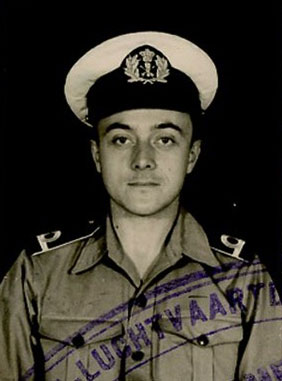
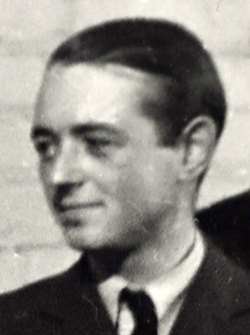 Harry
Hack (on left) was very much in command and appeared to enjoy the
challenge of getting the lifeboat and its passengers to England. If the weather were to change the over crowded small boat
could be in difficulty and he asked Marien de Jonge, an experienced
yachtsman, to take the helm.
Harry
Hack (on left) was very much in command and appeared to enjoy the
challenge of getting the lifeboat and its passengers to England. If the weather were to change the over crowded small boat
could be in difficulty and he asked Marien de Jonge, an experienced
yachtsman, to take the helm.
With this problem out
of the way he returned his attention to the engine. It was running on
only one cylinder and in danger of over heating. When this happened the
engine had to be disengaged from the propeller, the
lifeboat then lost way, drifted and would not respond to the
helm. They appeared to be drifting closer to the shore and the
passengers became nervous and restless.
Loet Velmans describes what happened next:
"A man with a double-barreled name and the title Jonkheer signifying membership of the Dutch nobility started bellowing at the top of his voice, demanding that we return to port - 'for the sake of the women and children'. It started as an open debate and he had some support from the older passengers but then the argument got ugly, there was a lot of pushing and shoving. When I realised that what we were talking about involved the risk of our being arrested by the Gestapo, I began to shake. This was a serious business - our very survival was at stake."
"Then
a lone voice, timid and hesitant, suggested a vote. Before the polling
could start, however, one of the students finally took charge and shouted 'If you don't like it, you can swim back'. The
mutiny subsided as quickly as it had began" (Loet Velmans)
Harry Hack came on deck from the engine compartment and describes how:
... our 'first mate' pours out his heart: "We don't have a ghost of a chance to arrive at the other side. We better go back."
Our answer is brief and to the point: "We go on!"
"In that case I cannot any longer accept responsibility for what will
result in a collective suicide." He rejoins the passengers again.
Marien de Jonge had
left behind his wife and two week old son to go to England and fight
for Queen and Country but as an experienced yachtsman he knew the
weather in the North Sea could quickly change and with the lifeboat so
overcrowded there was at the very least a danger of being washed
overboard. He thought the wiser option would be to join the remnants of Dutch forces fighting on in Zeeland.
Was
Marien de Jonge right to be so concerned? Harry Hack's son, Radboud,
who initially trained as a naval architect before switching to aeronautical
engineering, thinks he was. When the Zeemanshoop
was launched in 1925 it was found to be significantly less stable than
comparable lifeboats and the NZHRM corrected this by adding 2.2 tons of
ballast to the keel increasing the
weight from 18 to 20.2 tons. The 46 passengers would have added another
3 tons to the weight of the lifeboat and, critically, this was at deck
level. Its stability was now far less than the minimum specified by
the NZHRM a few years earlier. For the technically minded, the NZHRM
initially had a metacentric height of 41 cm and after adding the
ballast this increased to 50 cm but Radboud Hack's calculations show
that on the 14 May 1940 the weight of the passengers reduced the metacentric height of the Zeemanshoop to only 33 cm.
De Jonge would not have known about this but would have sensed that the
lifeboat was unstable by the time it took to right itself after applying the helm and would
know that it was likely to become "een varende doodskist" - a floating
coffin - should the weather change. On the other hand the Jewish
passengers had nothing to loose, some
intended to poison themselves rather than be captured and Otto Neurath
had joked, “If we don’t find a boat I’m going on a piece of wood”.
Harry Hack may have
thought that "As long as the weather is good, we have a chance of
reaching England" while Marinus de Jonge was thinking "We are still
close to shore and if we head SSE we can safely reach the Dutch forces
fighting on in Zeeland". Once de Jonge was overruled he curled up in
the cabin area and went to sleep (Karel
Dahmen) and Lou Meijers who had learned to "steer a bit on the holiday
camps of the NJV" took over the helm.
This incident made Harry Hack think:
"First,
we had to face the fact that the passengers' nerves might break. We had
a doctor on board. He understood the situation and promised to keep an
eye on people. I asked him to let me know at the first sign of panic.
We could not afford to let things get out of control and sacrifice the
whole voyage for one person. Next, we decided to give people jobs to do
to take their minds off things: a look-out for floating mines and so
on. But: stay where you are! Second, we decided to make a list of all those onboard. Our doctor
reported 'no worries at present'." (Hack)
What significance
should be attached to Harry Hack's underlined words of caution "stay
where you are!" Did he realise that any attempt by the passengers to
gather on the same side of the lifeboat if a mine was sighted might result
in a capsize?
And who was this
doctor? There seems little doubt that it was Dr Simon Weijl (Weyl), who
fell in the water and had to be dragged aboard soaking wet, the last
person to join the Zeemanshoop
before it left Scheveningen. He was desperate to join his assistant
Liselotte Mayer and her German Jewish husband, Vicor Meyer, on the Zeemanshoop. Simon Weijl was a 46 year old psychiatrist
and neurologist with a practice in The Hague. His love for Liselotte
compelled his decision to leave the Netherlands. He was uniquely
qualified to assess how the passengers were coping with stress and
whether their behavious might endanger both them and the lifeboat.
Lou Meijers recalled that the list of passengers was made:
"...
because there were many German speakers among them. Later we copied
this list onto the back of a Chart of the Dutch Life Boat Stations. We
found this chart only after we had broken into a locker containing
emergency flares." (Meijers)
This list of names on the back of the chart of the Dutch lifeboat stations was the key to tracing the families of the passengers and crew of the Zeemanshoop.
Harry Hack was relieved when "the propeller can be engaged again and the cooling water valve
opened a bit more. We drifted many more times." (Harry Hack).
The compass sticks, its light fails and they steer by the Polar Star
and towards a star near the horizon. "The night passes. On deck
everything remains quiet. The engine is running steadily."
At about 04.30
the next morning, dawn, the stars fade away. Harry Hack goes on
deck, steps outside the rail and edges his way round the lifeboat walking along
the outside fender, the only place to put his feet:
"The
boat is low in the water, too low in fact. Water is splashing over the
freeboard. Meyers hands oilskin coats to those who tend to get wet. The
sun rises and starts warming us. We ought not to complain. It looks as
if it will be a beautiful, if uncertain, day. (Hack)
"The
weather remained excellent and the sea as calm as one could wish. This
was a very lucky fact, because, if the weather had been even a bit
worse, without any doubt we would have lost some people. At dawn, we
started to redistribute the deck load as we were a bit nose-heavy. Also
the two man-holes were inspected, and from them emerged very useful
things like oilskins and emergency rations. The rations were stored
safely and well in the engine room because we had no idea how long the
trip to England would take, and the emergency rations were only to be
used in case of a real emergency. From the beginning there was a great
need for liquid. (Meijers)
"At
daybreak a formation of bombers flew over us. We assumed they were
German though they were too high for us to gauge whether they were
friend or foe. An elderly couple told the sergeant that he had better
hide his rifle under his coat; if he didn't we might be mistaken for a
military target. The unidentified aircraft ignored us. They were
undoubtedly after bigger game. The
sun rose in a breath taking pink dawn" and "except for the children
nobody complained of hunger or thirst; we were too scared, too excited
or both." (Velmans)
The passengers had
stood throughout the night, holding onto the hand rails and staring out
to sea and as the sun rose on the smooth glassy sea Dr Weijl and
Liselotte noted that many claimed to see church steeples rising from
the water on the far horizon, a halucination induced by fatigue and
stress.
Harry Hack returned to the engine room where things were now going well and he was able to relax until he suddenly realised that
"...
it was madness to continue on a North-West course any longer. On this
course we would never arrive at the coast of England, and certainly not
at the Thames Estuary where the chances of being picked up would be
better. Back on deck for a captain's council. App. 08.00 Decision to
alter course to West."
He now decided to risk starting the second cylinder,
"The
only problem was that pre-heating would be accompanied by flames and
the sound and fury of the blow lamp. And that may frighten some
passengers! I lit the blow lamp, the glowing plate was hot, fuel
injection engaged, and the stubborn "chook, chook, chook" turned into a
rhythmic "chooka chooka chooka" ...... The engine was running on two
cylinders! Praise be to Kromhout! The boat was gaining speed! A final
adjustment, keep an eye on it for a while, and then back on deck to
enjoy the warm sunshine. Great! But keep listening to the rhythm of the engine."
Karel Dahmen recalled that:
"The response to the helm was slow with only one cylinder firing but at the higher speed achieved with two cylinders working, the response was quite adequate. I sometimes had to turn the helm at short notice to steer around some of the objects spotted by the look outs and did not have a problem with the boat coming around. The problem I did have was that I couldn't easily see the objects with all the people standing in the way and I had to leave the cockpit to get a good look."
Everything
was going well but Harry was conscious of his responsibility and could
not relax for long. He began to worry about the fuel consumption now
that both cylinders were running at at full power. He had assumed that
a lifeboat would always be ready with full tanks but the fuel pipe
disappeared into an inaccessible corner and it was impossible to check
the level:
Without charts navigation was more a matter of guesswork:
"Now
the ship obeyed the helm much better, and it was decided to alter
course to W.S.W. For us, setting the course was a matter of guesswork
and being confident that the chart we had used during geography
lessons, had remained in our memories in the right proportions. We kept
this course up to approximately 15.00 hrs when the course was changed
to S.W. and later to S." (Meijers)
At
about 14.00 according to Hack (but Belinfante gave the time as 15.00
and Meijers as 16.15) "we saw four ships on the horizon":
"After
some deliberation the course was changed towards them, as we could
safely assume that they were not the enemy. They appeared to be paddle
steamers which, under the protection of some destroyers, were probably
mine-sweeping." (Meijers)
"As the lead ship came closer, a cheer went up. She was flying the Union Jack! She was a destroyer: the HMS Venomous - a name meant to strike fear into the enemy but one that to us meant we were safe at last." (Velmans)
"From
the stuff Meyers had found on his survey of the boat I put on an
oilskin, a yellow one, clearly visible. I position myself as
prominently as I can. At the stern we hoist the Dutch 'Red, white and
blue', on the mast the pennant of the Noord-en Zuid-Hollandsche Redding
Maatschappij (N.Z.H.R.M.) with a knot tied in it. 'In sjouw' as the
seaman calls it, which means that we need help.
We receive signals from a signaling lamp. Nothing
unusual for a decent vessel, but far beyond our capability. I can do
nothing better than wave my arms, expressing my helplessness. For some
time nothing happens. It looks as if they do not trust us. I stop the
boat.
Apparently, the destroyer now understands our
situation. A launch is lowered. Talking and fussing. I can't make head
or tail of it. One thing is for certain however: we have made it!!!
(Hack)
HMS Venomous and a sister ship were escorting HMS Sandown and HMS Ryde, two requisitioned Southern Railways paddle steamers which had carried passengers from Portsmouth to
the Isle of Wight but now formed the Dover Flotilla of minesweepers.
The Germans resented them sweeping up their newly laid mines and Venomous was there to prevent their activities being brought to an end by attacking German aircraft. AB Knapton recalled what happened when the Zeemanshoop was sighted:
As they climbed aboard the Dutch harbour tug Atjeh was sighted, with English naval offices standing on its bow. It also came alongside to transfer its passengers, including Cdr Goodenough's "demo" team from Ijmuiden. The story of the Atjeh and its mission to destroy Dutch fuel reserves before they fell into German hands is illustrated with more of Lt Peter Kershaw's photographs.
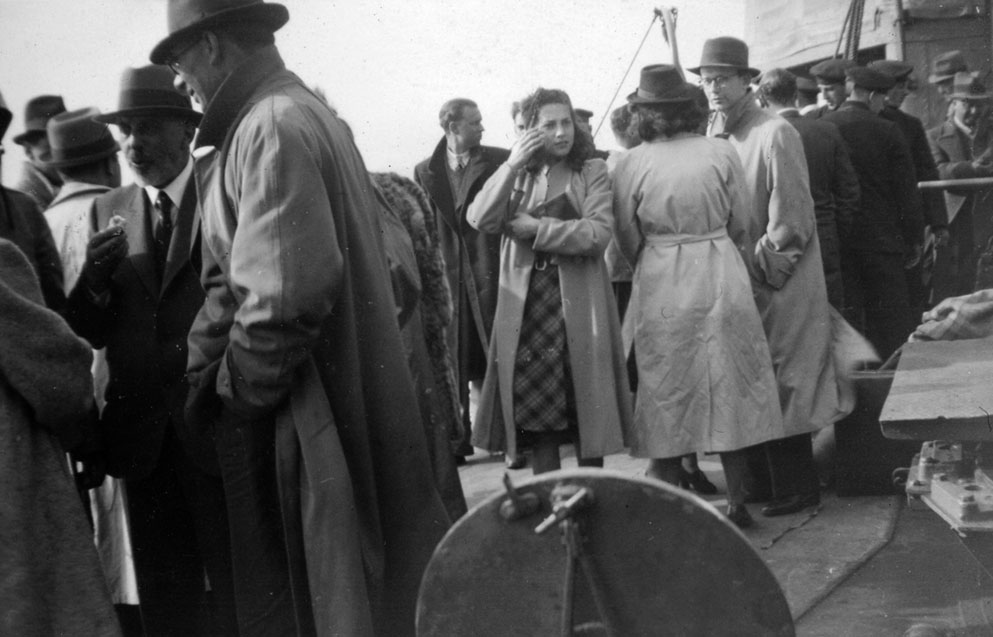
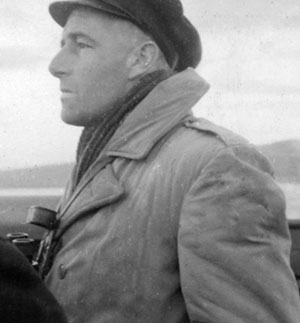
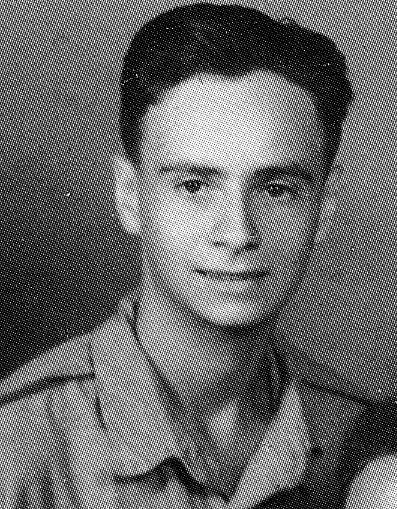
As the stress ebbed away Harry Hack could only remember fragments of what happened next:
But Loet Velmans (on left), the seventeen year old school boy, remembered that:
"An announcement came over the public address system: the Captain was inviting the crew of the Zeemanshoop
to join him on the bridge. Dick and I tagged along with the four
students, who were the true heroes of the day. The
captain showed us charts of the sea we had just crossed, pointing out
several minefields strung just below the surface of the water. We had
passed right over them, oblivious to the danger. It was only thanks to
our unusually shallow draft that our boat had not been blown to pieces.
He
also told us that our navigation skills left something to be desired.
The North Sea currents had driven us south toward the British Channel.
Had we continued on our course, we would have missed the English coast
altogether and been swept into the Atlantic Ocean, headed for the
American continent. We stared at the captain with a mixture of relief
and utter disbelief."
At first the student crew were asked to take the Zeemanshoop to Ramsgate but "After we told them in a friendly polite manner that we had no idea whatsoever of our position, we were told to also come on board. The Zeemanshoop continued her trip with another crew." (Meijers)
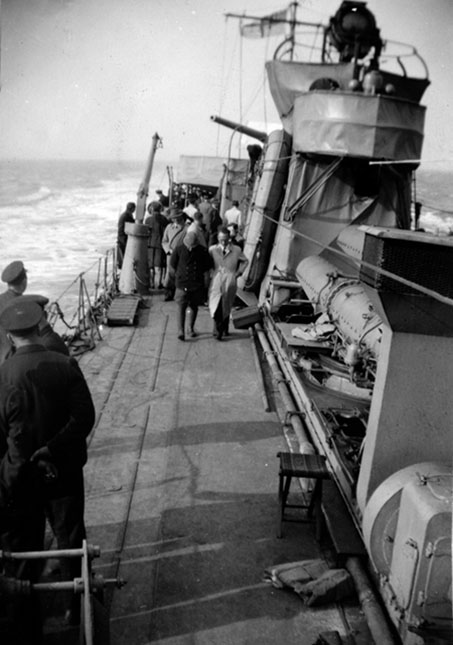
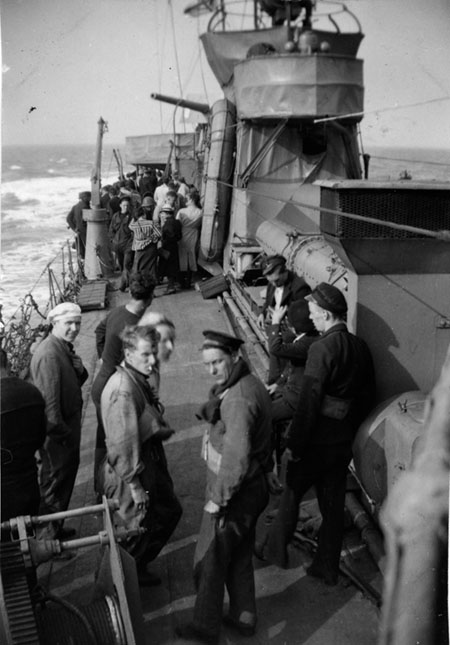
Venomous accelerated to 25 knots and headed for Dover where their passengers disembarked at about 19.00:
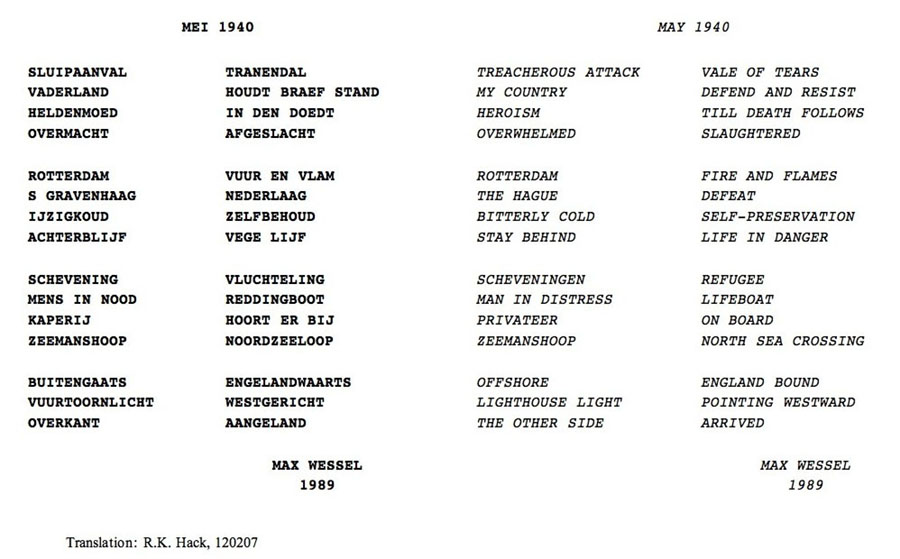
Max Louis Wessel escaped to England on the Zeemanshoop but his parents died in the Holocaust
He wrote this poem in 1989 on the eve of the fiftieth anniversary of the voyage
It has been translated into English by Radboud Hack, the son of Harry Hack
Back home in the Netherlands the following report was published on the 8 June in the Haagsche Courant:
"A significant loss for the fleet of the NZHRM is the disappearance of the rescue boat Zeemanshoop from station Scheveningen. On the evening of 14 May, this boat was captured by armed Dutch military, who saw the chance to start the engine and to sail out (of the harbour) with about 30 refugees on board. Whether the Zeemanshoop reached England (there was fuel for 15 hours) is unknown. Perhaps she was picked up drifting on the sea and brought to a British port. So there is still a slight chance that the NZHRM will recover, after the war, this excellent rescue boat, which has already conducted so many wonderful services in Scheveningen."
Technically, they had "stolen" the Zeemanshoop
but on the day that the Netherlands had surrendered and Germany had
taken over the whole country could that really be considered theft? Lou
Meijers had this to say at the end of his letter describing the voyage:
"I
end this letter offering my apologies for this affair. It was
absolutely illegal, but it saved the lives of many Jewish passengers
and for us was the ideal way out. In case in the future – which Heaven
forbid – our country might surrender again, the N.Z.H.R.M. is on my
list to again lose a lifeboat. As penance I ask you to register me as
contributor."
De
Booy, on paper the Secretary and Treasurer of the Royal Dutch Lifeboat
Association (NZHRM) but in practice the man who really ran it,
concluded his account of the voyage of the Zeemanshoop in Tusschen Mijnen en GrondzeeŽn with the following words:
"After all, the NZHRM did not lose the Zeemanshoop.The
trip of 14-15 May 1940 was one of her most splendid rescues and she was
of use to the Royal Netherlands Navy for five years. All honours to the
four students!"
What happened to the Zeemanshoop after its arrival in England - and where it is now?
Read the story of the Atjeh and Cdr Goodenough's "demo party"
Return to the Home Page of the Zeemanshoop